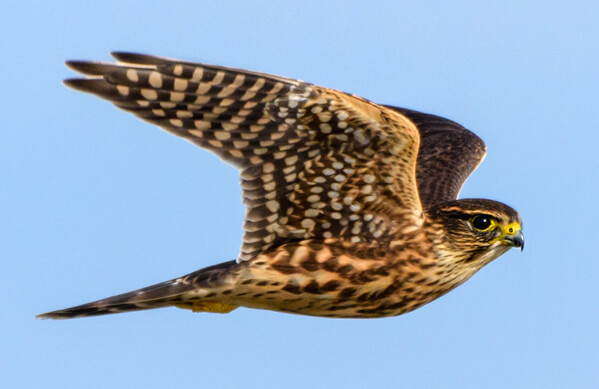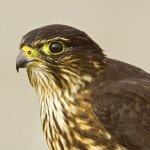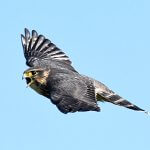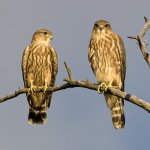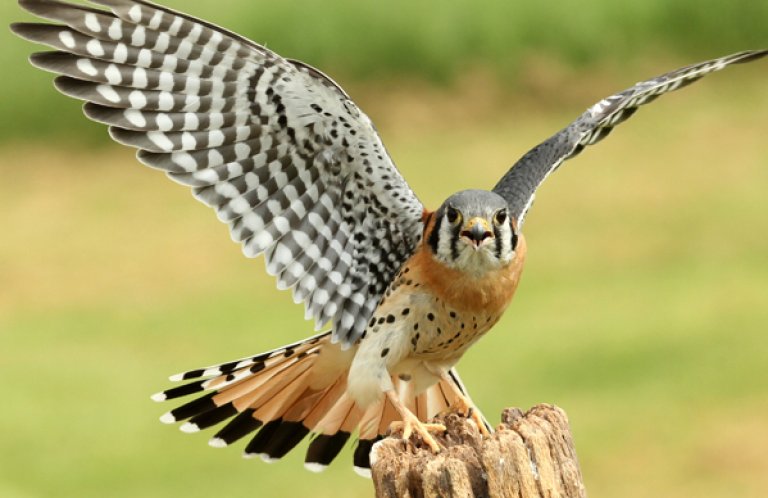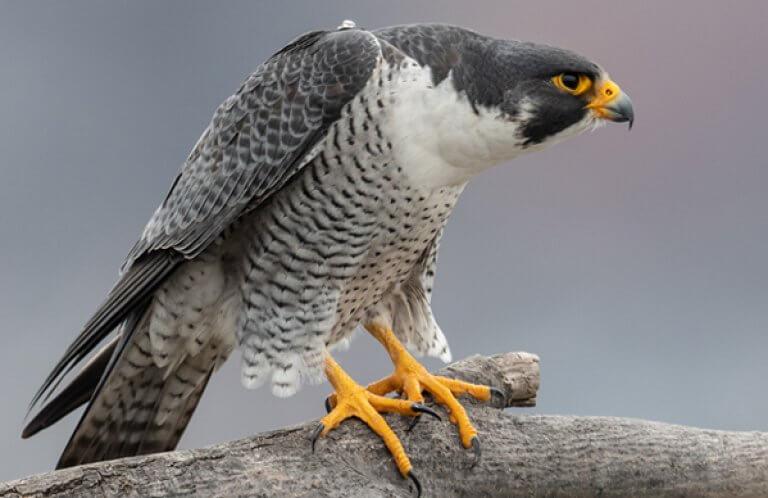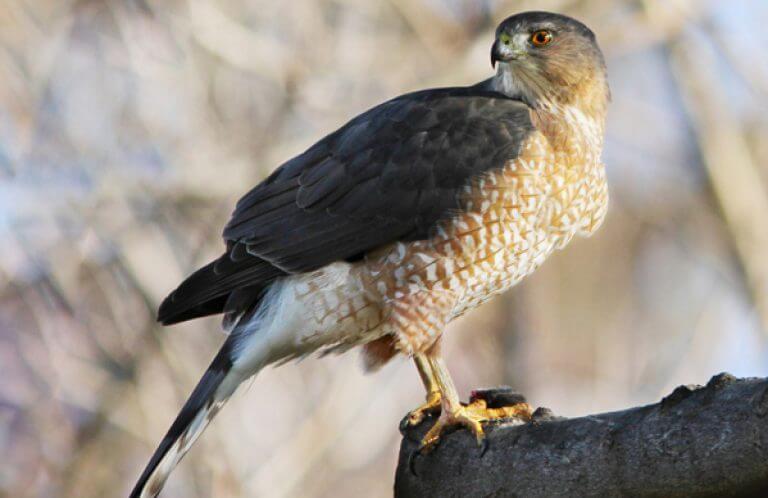About
A Falcon by Another Name
A formidable bird-hunter about the same length as the related American Kestrel, the Merlin is more powerfully built and seems far larger — more like a miniature Peregrine Falcon.
“The Merlin is to an American Kestrel what a Harley-Davidson motorcycle is to a bicycle,” wrote bird authorities Pete Dunne, David Sibley, and Clay Sutton in their seminal book Hawks in Flight. “In the air, the difference between a Merlin and an American Kestrel is not a matter of degrees, it is quantum.”
The shape-shifting wizard of legend might seem an apt inspiration for the Merlin's name, but instead, it comes from the French word esmerillon, meaning falcon. The wizard named Merlin, on the other hand, got his name from the Welsh name Myrddin; he was named after a real-life bard who was part of the inspiration for the mystical character perpetuated in King Arthur legends. Medieval falconers called the Merlin the “Lady's Hawk,” and royalty prized this small raptor for hunting Eurasian Skylarks and other avian prey. Fans included Mary Queen of Scots and Russia's Catherine the Great.
Songs and Sounds
Sounding Off
To the uninitiated, a calling Merlin can sound somewhat like a Killdeer, American Robin, or even a woodpecker. The typical alarm call, often given near a nest site, is a somewhat irritated-sounding whinny on one pitch.
(Audio of Merlin by Fraser Simpson, XC313348. Accessible at www.xeno-canto.org/313348.)
Breeding and Feeding
No-Nonsense Nester
Merlin pairs bond through varied courtship displays, including powerful flights and dives and fluttering flights by the male. Pairs share rocking glides and circling and soaring sessions. Females will beg food from males, with food transferred both in the air and at the perch. Merlin pairs may stay together for several seasons.
When it comes to nesting, Merlins choose their site carefully but do little nest-building or modification. A former crow or hawk nest is usually adopted, then perhaps barely modified before the female lays four or five rust-colored eggs marked with dark splotches. The nest is often high in a tree, frequently a conifer, and usually in a fairly open situation. A Merlin pair may also nest on a cliff or on the ground under heavy vegetative cover, or, rarely, in a tree cavity.
Incubation usually takes a month. Once the eggs hatch, the female broods the young for about a week. During this time the male fends off intruders, vigorously chasing off crows and other large birds. He brings in most of the food, which the female transfers to the young. After about a month in the nest, the young birds may linger from a week to a month, being fed by their parents.
In the wild, Merlins mostly hunt other birds. Unlike the Peregrine Falcon, they don't usually dive or “stoop” on their prey. Instead, they power up in horizontal flight, plowing into murmurations of starlings, clouds of sandpipers, and strong-flying pigeon flocks at speeds topping 30 miles per hour. They also pick off songbirds as small as the Yellow Warbler, be it on breeding grounds, during migration, or where they winter. Merlins also nab bats leaving their roost caves and prey on large insects including dragonflies.
This talented aerialist also terrorizes sandpiper, songbird, and pigeon flocks; indeed, its scientific name means “pigeon-like falcon” or “pigeon falcon.” Its common name was once Pigeon Hawk.
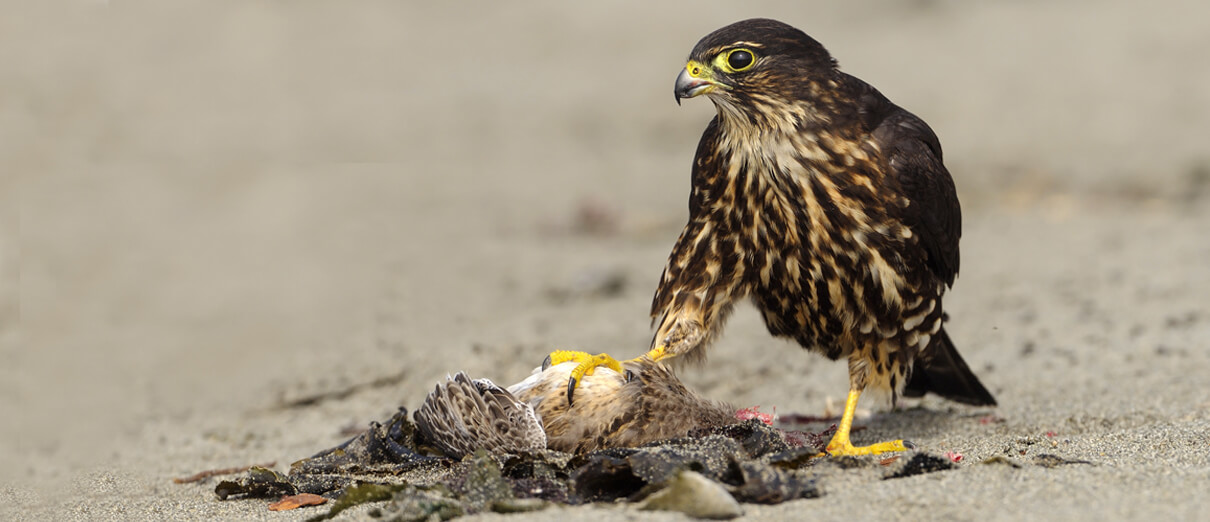
Region and Range
Northern Falcon
Merlins are not unique to North America. They nest across much of the northern half of the Northern Hemisphere, with most wintering well to the south.
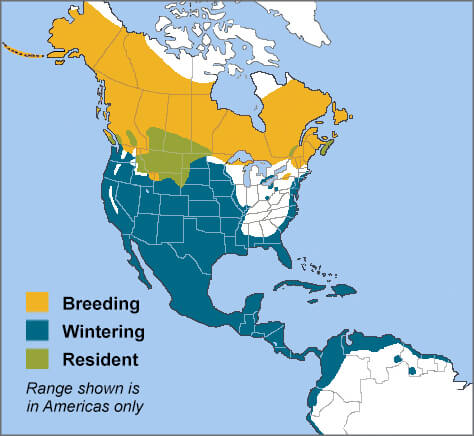
Three distinctive subspecies nest in Canada and the United States. The “Black” Merlin of the Pacific Coast region is mostly dark charcoal in color, solid on the back, wings, and tail. The “Prairie” or “Richardson's” Merlin is found in the center of the continent and is the lightest in color, with females having a pencil-lead-gray back and the males blue-gray backs. Streaks of brown (in females) and orangish (in males) adorn the birds' otherwise white underparts.
The most widespread subspecies is the “Taiga” Merlin. Its back color is dark gray, as are streaks running down its otherwise buffy underparts. In Eurasia, six other subspecies are found.
In the U.S., Merlins are found year-round along the northern Pacific Coast and in a large patch of the northern Great Plains. Otherwise, they have separate breeding and wintering ranges in North America, nesting from Alaska across most of Canada, then in parts of the northernmost contiguous U.S. states. In winter, they occur along all U.S. coastal regions and from the Pacific states through the western Great Plains. They also winter throughout Mexico, south to northwestern South America. A few reach Ecuador and Peru, the only countries within the Merlin's world range where they cross the Equator.
Conservation
Merlin's March
In recent decades, the fortunes of some raptors have greatly improved. One reason is the ban of DDT and other pesticides that worked up the food chain and thinned raptor egg shells to the point of collapse.
Another reason for the recovery of raptor populations is legal protection: It's illegal to hunt raptors in North America. Some species, including the Cooper's Hawk, have increased substantially and are now familiar in suburbs. The Merlin is a similar case: Partners in Flight (PIF) estimates that the species' population in the U.S. and Canada more than tripled between 1970 and 2014. Merlins are now found nesting in suburban and urban settings, and their breeding range has crept southward – for example, well into New York, New Hampshire, Vermont, and Maine.
Like other raptors, though, Merlins continue to face human-caused threats, including toxins that harm their prey and the birds themselves. Reflective glass also takes a toll on these fast-flying birds.
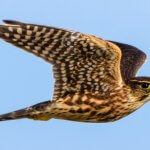
Help support ABC's conservation mission!
ABC has been instrumental in the cancellation of more than a dozen pesticides that are particularly harmful to birds, benefiting raptors such as the Merlin, Swainson's and Red-tailed Hawks, Bald and Golden Eagles, and many smaller bird species. We are continuing this work through our Pesticides program, part of our overall conservation strategy to eliminate threats to birds.Our Collisions program works on multiple fronts, from advocating for legislation to evaluating new glass products and educating architects, developers, and homeowners.
Get Involved
Policies enacted by the U.S. Congress and federal agencies, such as the U.S. Fish and Wildlife Service, have a huge impact on migratory birds. You can help shape these rules for the better by telling lawmakers to prioritize birds, bird habitat, and bird-friendly measures. To get started, visit ABC's Action Center.
Living a bird-friendly life can have an immediate impact on migratory birds in the United States. Doing so can be as easy as adding native plants to your garden, avoiding pesticides, and keeping cats indoors. To learn more, visit our Bird-Friendly Life page.
American Bird Conservancy and our Migratory Bird Joint Venture partners have improved conservation management on more than 8.5 million acres of U.S. bird habitat — an area larger than the state of Maryland — over the last ten years. That's not all: With the help of international partners, we've established a network of more than 100 areas of priority bird habitat across the Americas, helping to ensure that birds' needs are met during all stages of their lifecycles. These are monumental undertakings, requiring the support of many, and you can help by making a gift today.





































